Jie Hong
Structural Energy-Guided Sampling for View-Consistent Text-to-3D
Aug 23, 2025Abstract:Text-to-3D generation often suffers from the Janus problem, where objects look correct from the front but collapse into duplicated or distorted geometry from other angles. We attribute this failure to viewpoint bias in 2D diffusion priors, which propagates into 3D optimization. To address this, we propose Structural Energy-Guided Sampling (SEGS), a training-free, plug-and-play framework that enforces multi-view consistency entirely at sampling time. SEGS defines a structural energy in a PCA subspace of intermediate U-Net features and injects its gradients into the denoising trajectory, steering geometry toward the intended viewpoint while preserving appearance fidelity. Integrated seamlessly into SDS/VSD pipelines, SEGS significantly reduces Janus artifacts, achieving improved geometric alignment and viewpoint consistency without retraining or weight modification.
Enhancing Features in Long-tailed Data Using Large Vision Mode
Apr 15, 2025Abstract:Language-based foundation models, such as large language models (LLMs) or large vision-language models (LVLMs), have been widely studied in long-tailed recognition. However, the need for linguistic data is not applicable to all practical tasks. In this study, we aim to explore using large vision models (LVMs) or visual foundation models (VFMs) to enhance long-tailed data features without any language information. Specifically, we extract features from the LVM and fuse them with features in the baseline network's map and latent space to obtain the augmented features. Moreover, we design several prototype-based losses in the latent space to further exploit the potential of the augmented features. In the experimental section, we validate our approach on two benchmark datasets: ImageNet-LT and iNaturalist2018.
Maintain Plasticity in Long-timescale Continual Test-time Adaptation
Dec 28, 2024



Abstract:Continual test-time domain adaptation (CTTA) aims to adjust pre-trained source models to perform well over time across non-stationary target environments. While previous methods have made considerable efforts to optimize the adaptation process, a crucial question remains: can the model adapt to continually-changing environments with preserved plasticity over a long time? The plasticity refers to the model's capability to adjust predictions in response to non-stationary environments continually. In this work, we explore plasticity, this essential but often overlooked aspect of continual adaptation to facilitate more sustained adaptation in the long run. First, we observe that most CTTA methods experience a steady and consistent decline in plasticity during the long-timescale continual adaptation phase. Moreover, we find that the loss of plasticity is strongly associated with the change in label flip. Based on this correlation, we propose a simple yet effective policy, Adaptive Shrink-Restore (ASR), towards preserving the model's plasticity. In particular, ASR does the weight re-initialization by the adaptive intervals. The adaptive interval is determined based on the change in label flipping. Our method is validated on extensive CTTA benchmarks, achieving excellent performance.
DGNS: Deformable Gaussian Splatting and Dynamic Neural Surface for Monocular Dynamic 3D Reconstruction
Dec 05, 2024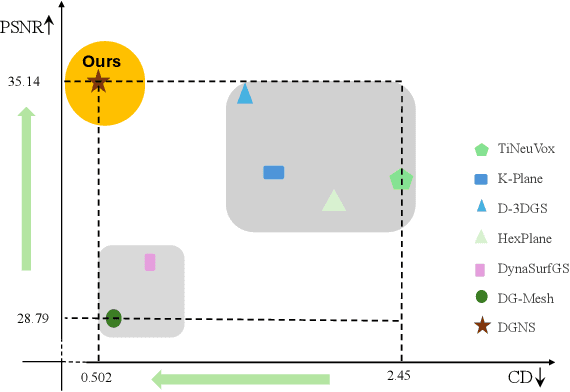
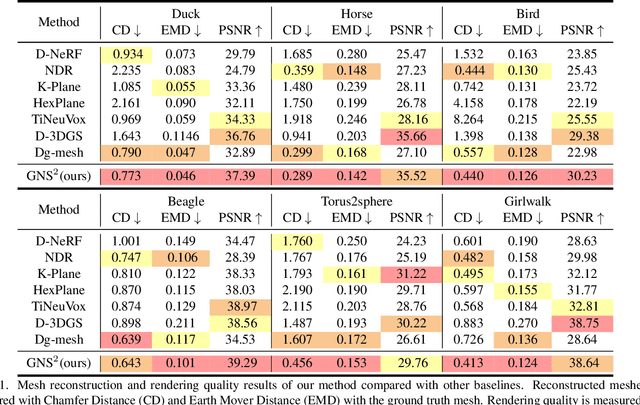

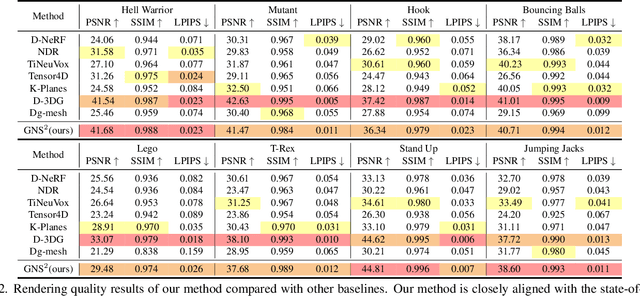
Abstract:Dynamic scene reconstruction from monocular video is critical for real-world applications. This paper tackles the dual challenges of dynamic novel-view synthesis and 3D geometry reconstruction by introducing a hybrid framework: Deformable Gaussian Splatting and Dynamic Neural Surfaces (DGNS), in which both modules can leverage each other for both tasks. During training, depth maps generated by the deformable Gaussian splatting module guide the ray sampling for faster processing and provide depth supervision within the dynamic neural surface module to improve geometry reconstruction. Simultaneously, the dynamic neural surface directs the distribution of Gaussian primitives around the surface, enhancing rendering quality. To further refine depth supervision, we introduce a depth-filtering process on depth maps derived from Gaussian rasterization. Extensive experiments on public datasets demonstrate that DGNS achieves state-of-the-art performance in both novel-view synthesis and 3D reconstruction.
Viewpoint Consistency in 3D Generation via Attention and CLIP Guidance
Dec 03, 2024



Abstract:Despite recent advances in text-to-3D generation techniques, current methods often suffer from geometric inconsistencies, commonly referred to as the Janus Problem. This paper identifies the root cause of the Janus Problem: viewpoint generation bias in diffusion models, which creates a significant gap between the actual generated viewpoint and the expected one required for optimizing the 3D model. To address this issue, we propose a tuning-free approach called the Attention and CLIP Guidance (ACG) mechanism. ACG enhances desired viewpoints by adaptively controlling cross-attention maps, employs CLIP-based view-text similarities to filter out erroneous viewpoints, and uses a coarse-to-fine optimization strategy with staged prompts to progressively refine 3D generation. Extensive experiments demonstrate that our method significantly reduces the Janus Problem without compromising generation speed, establishing ACG as an efficient, plug-and-play component for existing text-to-3D frameworks.
Latent-based Diffusion Model for Long-tailed Recognition
Apr 06, 2024Abstract:Long-tailed imbalance distribution is a common issue in practical computer vision applications. Previous works proposed methods to address this problem, which can be categorized into several classes: re-sampling, re-weighting, transfer learning, and feature augmentation. In recent years, diffusion models have shown an impressive generation ability in many sub-problems of deep computer vision. However, its powerful generation has not been explored in long-tailed problems. We propose a new approach, the Latent-based Diffusion Model for Long-tailed Recognition (LDMLR), as a feature augmentation method to tackle the issue. First, we encode the imbalanced dataset into features using the baseline model. Then, we train a Denoising Diffusion Implicit Model (DDIM) using these encoded features to generate pseudo-features. Finally, we train the classifier using the encoded and pseudo-features from the previous two steps. The model's accuracy shows an improvement on the CIFAR-LT and ImageNet-LT datasets by using the proposed method.
Backpropagation-free Network for 3D Test-time Adaptation
Mar 27, 2024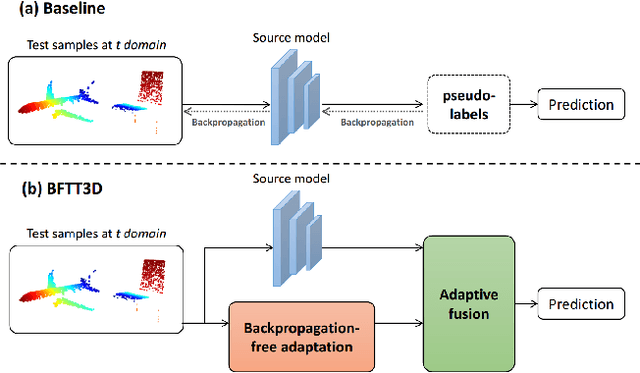

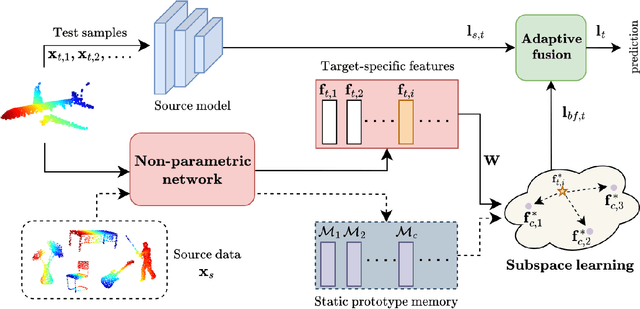

Abstract:Real-world systems often encounter new data over time, which leads to experiencing target domain shifts. Existing Test-Time Adaptation (TTA) methods tend to apply computationally heavy and memory-intensive backpropagation-based approaches to handle this. Here, we propose a novel method that uses a backpropagation-free approach for TTA for the specific case of 3D data. Our model uses a two-stream architecture to maintain knowledge about the source domain as well as complementary target-domain-specific information. The backpropagation-free property of our model helps address the well-known forgetting problem and mitigates the error accumulation issue. The proposed method also eliminates the need for the usually noisy process of pseudo-labeling and reliance on costly self-supervised training. Moreover, our method leverages subspace learning, effectively reducing the distribution variance between the two domains. Furthermore, the source-domain-specific and the target-domain-specific streams are aligned using a novel entropy-based adaptive fusion strategy. Extensive experiments on popular benchmarks demonstrate the effectiveness of our method. The code will be available at https://github.com/abie-e/BFTT3D.
Continual Test-time Domain Adaptation via Dynamic Sample Selection
Oct 05, 2023



Abstract:The objective of Continual Test-time Domain Adaptation (CTDA) is to gradually adapt a pre-trained model to a sequence of target domains without accessing the source data. This paper proposes a Dynamic Sample Selection (DSS) method for CTDA. DSS consists of dynamic thresholding, positive learning, and negative learning processes. Traditionally, models learn from unlabeled unknown environment data and equally rely on all samples' pseudo-labels to update their parameters through self-training. However, noisy predictions exist in these pseudo-labels, so all samples are not equally trustworthy. Therefore, in our method, a dynamic thresholding module is first designed to select suspected low-quality from high-quality samples. The selected low-quality samples are more likely to be wrongly predicted. Therefore, we apply joint positive and negative learning on both high- and low-quality samples to reduce the risk of using wrong information. We conduct extensive experiments that demonstrate the effectiveness of our proposed method for CTDA in the image domain, outperforming the state-of-the-art results. Furthermore, our approach is also evaluated in the 3D point cloud domain, showcasing its versatility and potential for broader applicability.
Hyperbolic Audio-visual Zero-shot Learning
Aug 24, 2023



Abstract:Audio-visual zero-shot learning aims to classify samples consisting of a pair of corresponding audio and video sequences from classes that are not present during training. An analysis of the audio-visual data reveals a large degree of hyperbolicity, indicating the potential benefit of using a hyperbolic transformation to achieve curvature-aware geometric learning, with the aim of exploring more complex hierarchical data structures for this task. The proposed approach employs a novel loss function that incorporates cross-modality alignment between video and audio features in the hyperbolic space. Additionally, we explore the use of multiple adaptive curvatures for hyperbolic projections. The experimental results on this very challenging task demonstrate that our proposed hyperbolic approach for zero-shot learning outperforms the SOTA method on three datasets: VGGSound-GZSL, UCF-GZSL, and ActivityNet-GZSL achieving a harmonic mean (HM) improvement of around 3.0%, 7.0%, and 5.3%, respectively.
PointCaM: Cut-and-Mix for Open-Set Point Cloud Analysis
Dec 05, 2022Abstract:Point cloud analysis is receiving increasing attention, however, most existing point cloud models lack the practical ability to deal with the unavoidable presence of unknown objects. This paper mainly discusses point cloud analysis under open-set settings, where we train the model without data from unknown classes and identify them in the inference stage. Basically, we propose to solve open-set point cloud analysis using a novel Point Cut-and-Mix mechanism consisting of Unknown-Point Simulator and Unknown-Point Estimator modules. Specifically, we use the Unknown-Point Simulator to simulate unknown data in the training stage by manipulating the geometric context of partial known data. Based on this, the Unknown-Point Estimator module learns to exploit the point cloud's feature context for discriminating the known and unknown data. Extensive experiments show the plausibility of open-set point cloud analysis and the effectiveness of our proposed solutions. Our code is available at \url{https://github.com/ShiQiu0419/pointcam}.
 Add to Chrome
Add to Chrome Add to Firefox
Add to Firefox Add to Edge
Add to Edge